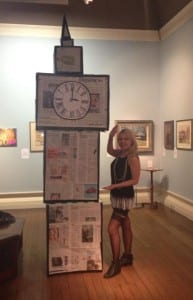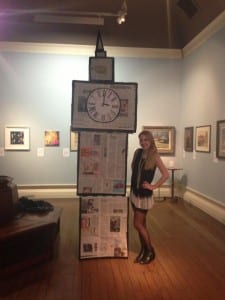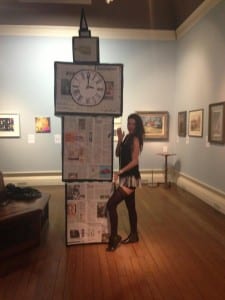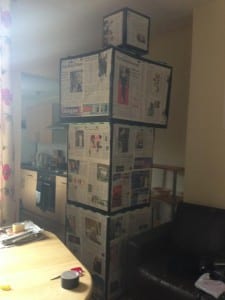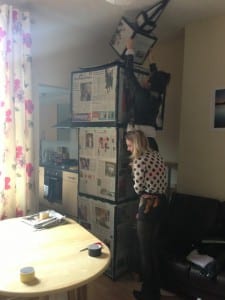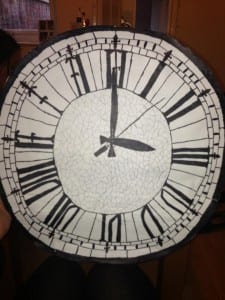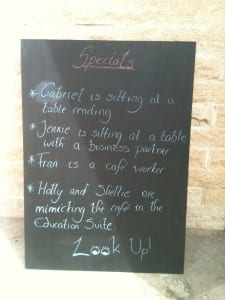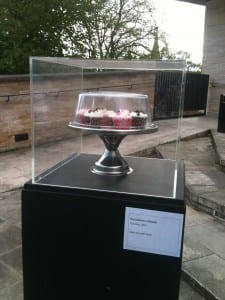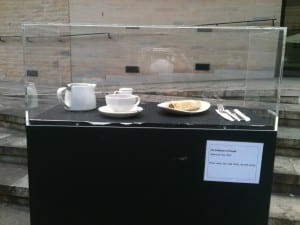Our final performance started with panic and worry as the weather in the morning leading up to our performance in the afternoon, was pouring with rain. As our performance was outside it would mean standing and sitting in the rain for two hours and potentially result in no audience members. Luckily however, when we began performing at 12pm, the rain stopped and the sun came out bringing audiences members with it. My role involved standing on a platform in the entrance of the outside seating area with a plinth and chalkboard informing the visitors of our outside cafe exhibition and inviting them to come and have a look:
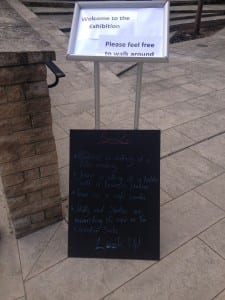
My role involved speaking quotes I had recorded from the staff members in the cafe. As a majority of the quotes were questions, I decided to say the quotes when visitors walked past or stood and looked at me, to create an interaction with them and highlight the staff members interaction and communication with the customers. As I was asking rhetorical questions and not looking at the visitors when I spoke to them, the reactions I got varied from person to person. For instance, some people looked at me but chose to ignore me, some replied to my questions with their own answers and some avoided walking near me and looking at me to prevent interaction. These observations were similar to the observations my group and I had made of the customers in the cafe. Even though a lot of the passers by acknowledged me and showed an interest there were a few who didn’t want to associate themselves with something unordinary. Like an earlier prediction I made in an earlier blog post, I mentioned we would get interest from children. This happened with a little girl who saw me and when I spoke and repeated questions when they walked past she questioned her family, repeatedly asking them if i was real. This made me think, as I was not acting like a normal person and was just stood still, she thought I was a robot or a statue as I was acting in a conventional, normal way. Children were also interested in the other areas of our performance such as, the cake stand and tea set as they kept going over to the glass plinths and looking at them.
Whilst I was stood on the platform, I was thinking of ways the performance could have been improved. For example, I could have pushed my role further by maybe having some clear plastic boxes with coin slots on the top labelled ‘REACTED’, ‘IGNORED’ and ‘INTERACTION’ and every time a visitor did one I would put a coin into one of the slots and at the end tally up how many coins were in each box to compare people’s reactions to our performance. Having Shellie and Holly visible in the education room upstairs representing ‘THE MIMIC’ proved successful as a lot of passers by and visitors noticed them and interacted with them by waving and looking into the outside area to see what else was going on. Whilst on the platform I overheard some customers who were sat outside, notice and mention the ‘OBSERVATION’ sign which was on the window above where Gabriel and Jennie were sitting. As a result they then looked around and noticed the ‘MIMIC’ in the window behind them.
Unfortunately, we didn’t have a massive audience and people didn’t use the space as I thought they would. I imagined the visitors to walk around the space like they would in a gallery, moving around and looking at all the artefacts but instead they walked through to get to the cafe and didn’t really stop to look. As Pearson states in Site- Specific Performance, ‘at site the audience may be incidental- those present in the same place at the same time – and obdurate’ (Pearson, 2010, p. 17). Therefore, the audience members were there because they were visiting the Collection Gallery and not specifically to see our performance like they would if the performance was set in an auditorium of a theatre as ‘in the auditorium, the audience is cast as audience: purposefully assembled, expectant, disposed, potentially appreciative.’(Pearson, 2010, p. 17)
I think if we were to do it again we would need to make the exhibition more obvious and create more exhibits for the audience to view and observe. I also think Jennie, Gabriel, me and the empty cafe window would need placards in front of us to demonstrate more what we were trying to do and make it clear we were artefacts in an exhibition. I think we would also need to make more exhibits and make our piece more obvious instead of subtle.
Our original plan was to perform for half an hour and make it a short piece, however, as we didn’t know how many audience members or visitors were going to attend we started our performance at 12pm and finished just after half 1 and therefore Gabriel and Jennie repeated their quotes and we would continue if the outside area was busy. However, by half 1 the cafe wasn’t as busy and we decided to stop.
Pearson, M (2010) Site- Specific Performance Basingstoke: Palgrave MacMillan.
